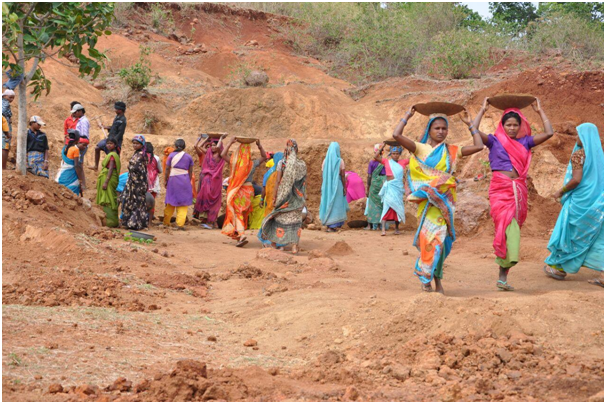Mahatma Gandhi National Employment Guarantee Scheme (MGNREGS
Context: This financial year, the average days of employment provided per household under the MGNREGS is at a five-year low.
More on the news
- The average days of employment provided per household is 42 days in 2022-23 while it was 50 days in 2021-22, 52 days in 2020-21, 48 days in 2019-20 and 51 days in 2018-19.
- Officials believe that there has been a decline in demand for jobs under the scheme this financial year as opposed to the two pandemic years, when a significant population depended on MGNREGS to make up for the deficit in their income created by job loss.
- Experts and activists believe that the programme has been plagued by systemic problems that are disincentivizing participation.
- Person days under MGNREGS is defined as the total number of work days by a person registered under the scheme in a financial year.
- In states such as Arunachal Pradesh , Chhattisgarh, Goa (18.03%), Haryana, Manipur (14. 52%), Meghalaya, Andaman Nicobar, Daman & Diu (0%) and Lakshadweep participation has remained suboptimal.
What is MGNREGS?
- The MGNREGA provides a legal guarantee for one hundred days of employment every financial year to adult members of any rural household willing to do public work-related unskilled manual work at the statutory minimum wage.
- The Ministry of Rural Development (MRD), Govt of India is monitoring the entire implementation of this scheme in association with state governments
- This act was introduced with an aim of improving the purchasing power of the rural people, primarily semi or unskilled work to people living below poverty line in rural India.
- Roughly one-third of the stipulated work force must be women.
Issues plaguing the scheme
- Misgovernance and Corruption
- Several activists admitted that there is rampant corruption in the implementation of MGNREGS.
- There have been allegations of fake bills, panchayat functionaries withholding job cards of workers and siphoning off funds, forged master rolls of workers, and work done with earthmovers and machines being passed off as MGNREGS work.
2. Centre-State Conflict
- The Centre has ₹2,605.82 crore pending liabilities for the wage component under MGNREGS to West Bengal.
- The funds to West Bengal had been stopped due to non-compliance of directives of the Central Government” under Section 27 of the MGNREGA, 2005.
- Section 27 states that the Central government may order stoppage of release of funds to the scheme and institute appropriate remedial measures for proper implementation within a reasonable period of time.
- The allegations of corruption against the State government, the Centre’s reluctance to release payments and the plight of the workers caught in this tussle reflect that much more needs to be done when it comes to policy execution.
3. Delays in MGNREGS social audits
- According to the report titled ‘Social audit calendar vs audits completed’ released in September by the MoRD, only 14.29% of the planned audits have been completed in this financial year.
- The audit involves quality checks of infrastructure created under the MGNREGS, financial misappropriation in wages, and checking for any procedural deviations.
4. Digitisation compatibility issues
- The introduction of technical complexities like an app for attendance at worksites has caused more hardships for workers.
Way forward
There is need for coordination both between centre and state along with the state looking at smooth execution of policies at ground level. Funds should be dispersed with accuracy and proper social audits should be done to improve the implementation of the scheme.
| Practice Question
1. Critically evaluate the performance of MGNREGS since its inception? How has it changed the lives of people both socially and economically? |




